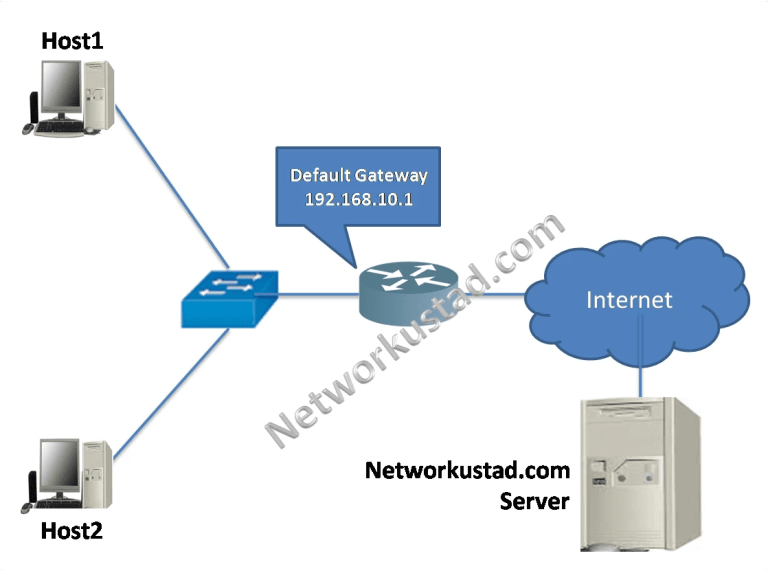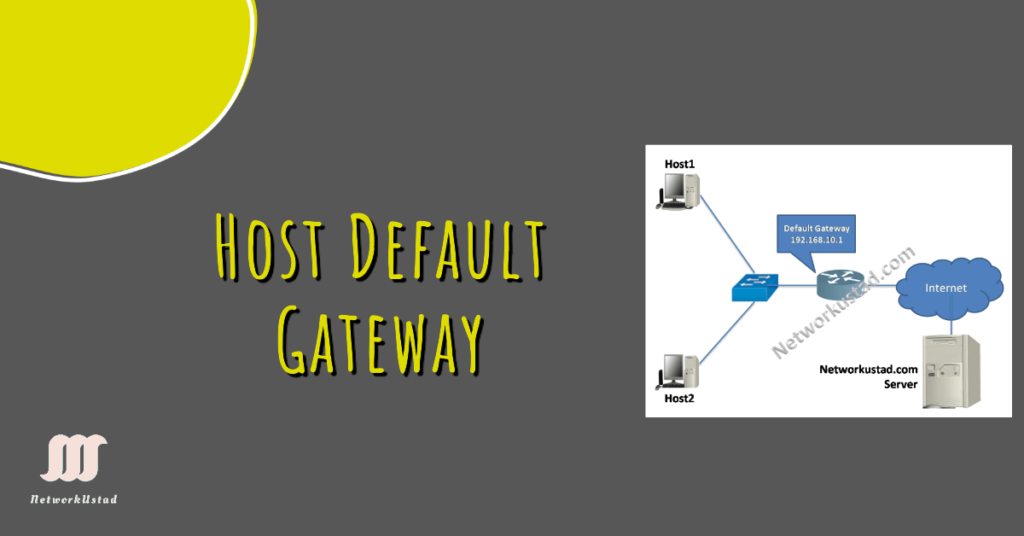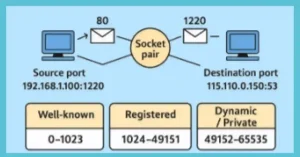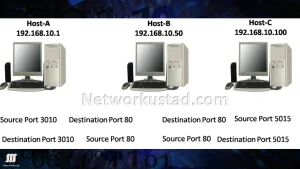When a host needs to communicate with another device on the network, it uses two critical components: the host’s default gateway and the routing table. This article explains how these elements work together to ensure packets reach their destinations. In 2025, the host default gateway’s role has expanded with 5G and IoT networks, where dynamic routing tables adapt to millions of connected devices in real-time.
The host’s default gateway routes traffic from one network to another. Generally, the router works as the host’s default gateway, allowing devices on one network to communicate with other devices. Its primary purpose in most homes and small offices is to direct Internet traffic from the local network to the cable or DSL modem, which connects to the Internet service provider (ISP) and vice versa.
A PC or computer that does not know the IP address of the default gateway is like a person in a home who does not know where the main gate is. They can talk to other people in the house or network, but there is no way out if they do not see the gateway address or there is no gateway.
The Host Default Gateway
When a host communicates outside its local network, it uses the default gateway, typically the router interface address (e.g., 192.168.10.1) on the same subnet. In 2025, DHCPv6 enhances this process for IPv6 scalability. The host IP address and the router interface address should be on the same network. A host’s routing table usually includes a gateway address. The host can dynamically receive the IPv4 address of the default gateway from DHCP services, or we can configure it manually.
The figure below illustrates the PCs in the local network configured with the gateway’s IPv4 address of 192.168.10.1. If a default getaway is configured on the host, it creates a default route in the host’s routing table. A default route is a route a computer will take when contacting a remote network. IPv4 address 192.168.10.1 is the address of the router interface, which is the default gateway for the hosts. The default route results from the host’s default gateway configuration and is placed in the host computer’s routing table.
If host1 sends a packet to http://networkustad-a2bb2f.ingress-alpha.ewp.live, which is not in the same network as host1, host1 sends the packet to the router. The router accepts the packet, accesses its routing table to decide the correct exit interface based on the destination address, and then forwards the packet using the proper interface to reach networkustad-a2bb2f.ingress-alpha.ewp.live.

The figure illustrates that the router connects the local network and the internet provider. Each host device is configured with the correct gateway address. The hosts are in the same subnet, so they don’t need a gateway to communicate with each other. The gateway address is the only required destination IP address and MAC address. The gateway address is not used when host1 sends a packet to host2 on the same network. Host1 forwards the packet directly to Host2 through the switch using the IP address of PC-2.
As of 2025, DHCPv6 with Prefix Delegation enhances default gateway assignment for IPv6 networks, supporting scalable deployments in smart cities.
The Switch Default Gateway
Switches, as Layer 2 devices, don’t require IP addresses unless configured with an SVI for remote management across networks. In 2025, VRF enhances switch gateway configurations for multi-tenant setups. But suppose you want to connect to the switch remotely for administration purposes over multiple networks. In that case, you must configure the SVI with an IPv4 address, subnet mask, and gateway address.
In other words, to remotely access the switch from another network using SSH or Telnet, the switch must have an SVI with an IPv4 address, subnet mask, and default gateway address configured. If the switch can be accessed from a host within the local network, then the switch gateway address is not required. The default gateway address must be configured on each device that wants to communicate beyond the local network.
The gateway address is typically the address of a router interface connected to the switch. To configure a host default gateway on a Cisco switch, use the “IP default-gateway” command in global configuration mode. Packets originating from host computers connected to the switch already have the gateway address configured on their host computer operating systems. So, the host computer does not need a default gateway configured on the switch. The IP address and default gateway information are used only packets originating from the switch.
In 2025, switches in enterprise networks use Virtual Routing and Forwarding (VRF) to manage multiple default gateways, improving isolation for multi-tenant environments.
Host routing table
A routing table is a set of rules determining where packets will be forwarded. We can check the host routing table on the Windows operating system using one of the following commands.
- route print
- netstat -r
The commands can display the host routing table. Both commands generate the same result. Entering the netstat -r command or the route print command displays the result, which has three sections related to the current TCP/IP network connections:
Interface List
This section lists and shows the MAC address and assigned interface number of every network-capable interface on the host, including Ethernet, WI-Fi, and Bluetooth adapters.
IPv4 Routing Table
This section displays all IPv4 routes, direct connections, local networks, and local default routes.
IPv6 Routing Table
This section displays all IPv6 routes, direct connections, local network, and local default routes.
IPv4 vs. IPv6 Default Gateways
IPv4: Manually configured or via DHCP
IPv6: Often auto-configured via Router Advertisement (RA) messages. Use ip -6 route show it to view the IPv6 default route, as shown below
default via fe80::1 dev eth0 proto ra metric 100
The key difference between IPv4 and IPv6 gateways is that IPv6 gateways don’t always require manual setup.
Types of Routes
- Directly Connected: Networks the host is part of (e.g.,
192.168.1.0/24). Read More about Directly connected Static Route - Static Routes: Manually added (e.g.,
route add 10.0.0.0 mask 255.0.0.0 192.168.1.2). Read More about static route - Dynamic Routes: Learned via protocols (rare on hosts, shared on routers). Read More about Dynamic Routes
- Default Route: The “catch-all” path (
0.0.0.0/0for IPv4,::/0for IPv6). Read More about default route
Route Prioritization
- Longest Prefix Match: A route to
192.168.1.0/24is preferred over192.168.0.0/16. - Administrative Distance: Lower values are prioritized (e.g., static route = 1, OSPF = 110).
How Hosts Use the Default Gateway and Routing Table
- The subnet mask checks if the destination IP is on the local network.
- If remote, it forwards the packet to the default gateway.
- The gateway’s MAC address is resolved via ARP (IPv4) or NDP (IPv6).*
Step-by-Step Workflow
[Start] │ ▼ Is destination local? → Yes → ARP/NDP for MAC → Send directly │ No │ ▼ Check routing table → Longest prefix match → Forward to gateway
IPv6 Example
- Host
2001:db8:1::10/64pings2001:db8:2::20. - Since the destination is on a different subnet, the host uses its IPv6 default gateway (
fe80::1). - NDP resolves
fe80::1to a MAC address (useip -6 neigh showto verify).
Troubleshooting: Common Issues & Fixes
1. “Default Gateway Not Available” Error
Causes: Misconfigured IP/subnet, unreachable gateway.
# Check IP and gateway (Windows):
ipconfig /all
# Ping the gateway:
ping 192.168.1.1
# For IPv6:
ping6 fe80::1
2. Incorrect Route Prioritization
Scenario: A VPN route is ignored because the default gateway takes precedence.
Fix: Add a static route with a lower metric:
# On Linux: ip route add 10.0.0.0/8 via 192.168.1.2 metric 50 # On Windows: route add 10.0.0.0 mask 255.0.0.0 192.168.1.2 metric 50
3. Stale ARP/NDP Entries
# Clear ARP cache (Windows): arp -d * # Clear IPv6 neighbors (Linux): ip -6 neigh flush dev eth0
Advanced Scenarios
1. Multiple Gateways
Use case: A laptop uses:
192.168.1.1for the general internet.10.0.0.1for a corporate VPN.
Solution: Add static routes for the VPN subnet:
route add 10.0.0.0 mask 255.255.0.0 10.0.0.1 metric 50
2. IPv6 Default Gateway Redundancy
- Hosts can accept multiple RAs from routers.
- Use
ip -6 route showto view multiple gateways.
In 2025, network management tools like SolarWinds or IPv6-aware diagnostics (e.g., ping6 -I) are crucial for resolving gateway issues in hybrid networks.
Table: IPv4 vs. IPv6 Routing
| Feature | IPv4 | IPv6 |
|---|---|---|
| Gateway Config | Manual/DHCP | RA Auto-Config |
| MAC Resolution | ARP | NDP |
| Default Route | 0.0.0.0/0 | ::/0 |
Conclusion
The host’s default gateway and routing table are vital for directing traffic in 2025 networks. Mastering these, with tools like “route print” and “ip -6 route“, ensures efficient connectivity and troubleshooting
FAQs
What is the purpose of a host default gateway?
The host default gateway routes traffic from the host to external networks when the destination IP isn’t on the local subnet.
How does a routing table differ from a host’s gateway settings?
Hosts use a default gateway for off-subnet traffic, while routers use detailed routing tables to choose paths across multiple networks.
What happens if a host’s default gateway is unreachable?
The host cannot communicate with devices outside its local subnet, leading to failed external connections.
Can a routing table have multiple entries for the same network?
Yes, routers prioritise routes based on metrics (e.g., hop count) to select the most efficient path.
How do hosts resolve MAC addresses for the default gateway?
Hosts use the ARP protocol to map the gateway’s IP address to its MAC address for Layer 2 communication.





